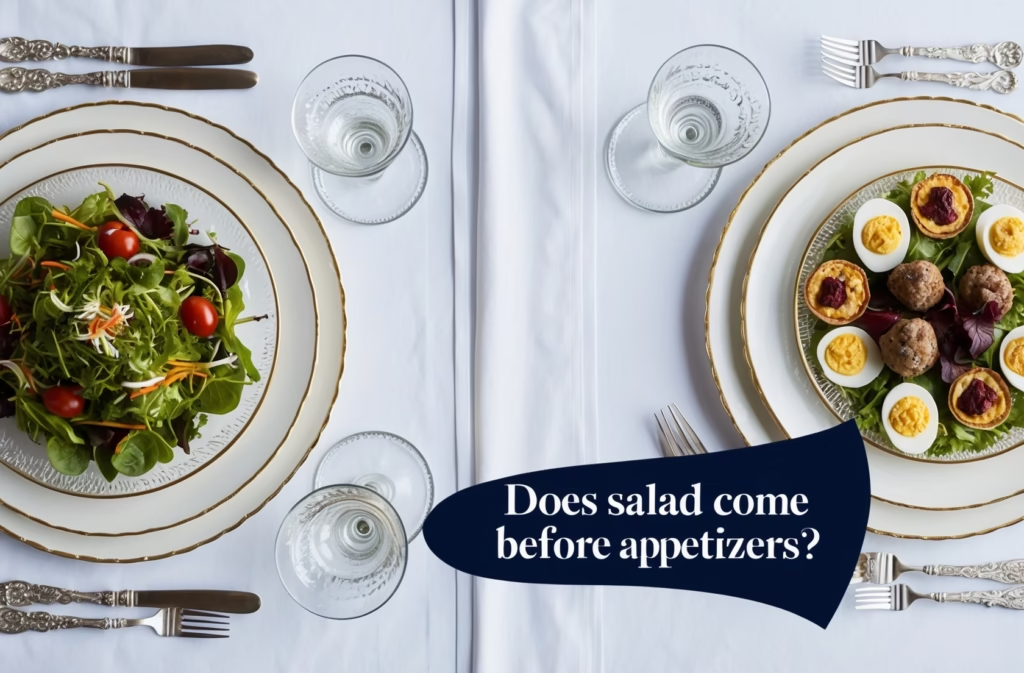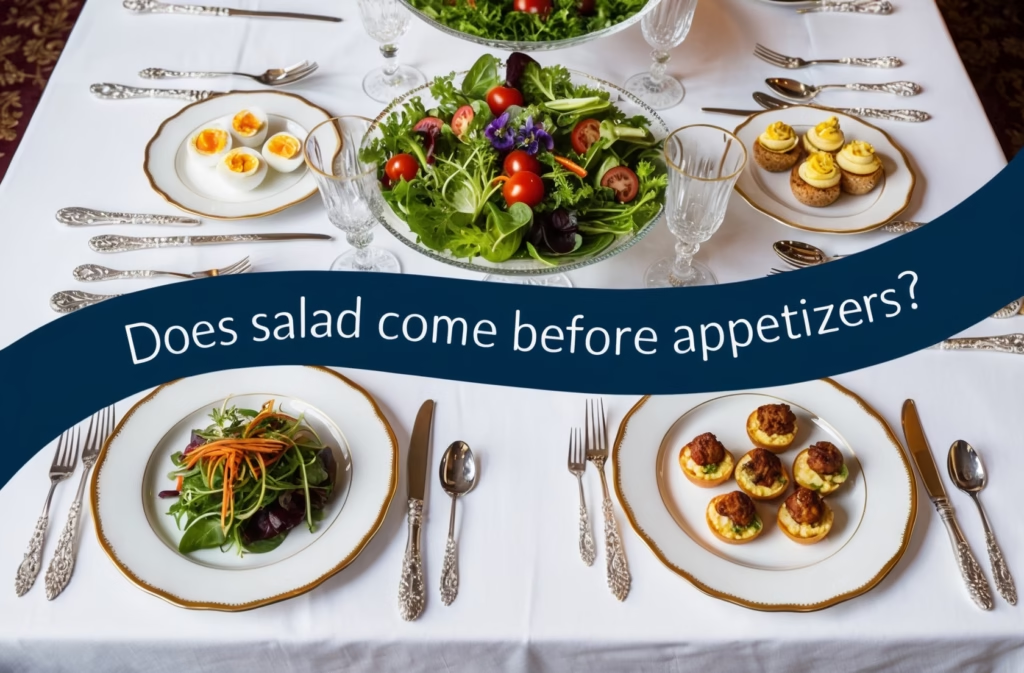Does Salad Come Before Appetizers? Uncover the proper Salad Order in a Meal! Settle the Appetizer vs Salad debate once and for all. Learn the etiquette and best practices!
Does Salad Come Before Appetizers? Deciphering the Order of Courses
The age-old question of Does Salad Come Before Appetizers? plagues many a dinner party and formal meal. Navigating the complexities of meal sequencing can feel like a culinary minefield, especially when tradition clashes with modern dining trends. This comprehensive guide will delve into the nuances of salad order in a meal, explore the differences between appetizers and salads, and finally, provide you with a definitive answer (and some exceptions!).
Understanding Appetizer vs Salad
Before we tackle the central question of Does Salad Come Before Appetizers, let’s clarify the distinctions between these two courses. Appetizers, by definition, are small dishes served to stimulate the appetite before the main course. They are designed to be light and flavorful, often served in bite-sized portions. Think of bruschetta, shrimp cocktail, or a creamy spinach and artichoke dip. These dishes are meant to whet your appetite, not fill you up.
Salads, on the other hand, while often light, can be more substantial. A hearty three-bean salad with fresh herbs like the one you can find at this link, for example, could be a complete meal on its own for some. The role of a salad in a formal meal is typically to cleanse the palate – a refreshing break before the main course, or sometimes even after. This is particularly true for lighter salads like a simple green salad or a vibrant chopped Italian salad such as the one described here.
The Traditional Approach: Salad After Appetizers
In traditional Western dining etiquette, the answer to Does Salad Come Before Appetizers? is a resounding no. Appetizers always precede salads. This follows a logical progression: you start with small, flavorful bites to awaken your taste buds, followed by a lighter salad to refresh your palate before the richness of the main course. The theory is that salads, particularly those with strong dressings, might interfere with the delicate flavors of the appetizers if served beforehand.
Consider a luxurious meal: You might start with delicate escargots or a sophisticated amuse-bouche, then a refreshing pear and gorgonzola salad like the one detailed on this page to cleanse your palate before moving on to the main event.
Modern Dining and the Evolution of Salad Order
However, modern dining trends have somewhat blurred these lines. The rigidity of traditional meal sequencing is less strictly adhered to in many casual settings. You might find restaurants serving salads as part of a larger appetizer course, or even as a standalone starter. In these contexts, the question of Does Salad Come Before Appetizers? becomes less relevant. The overall goal is to create a pleasant and enjoyable dining experience, regardless of strict adherence to tradition.
For instance, a restaurant might offer a selection of appetizers including a fattoush salad, a crispy and flavorful option which you can discover here, alongside other traditional appetizers.
Regional Variations and Cultural Influences
The answer to Does Salad Come Before Appetizers? can also vary significantly based on cultural and regional influences. In some cultures, salads are not a standard part of the meal structure, or they’re incorporated differently. What might be considered a salad in one culture could be a side dish or even a main course in another. Therefore, a universal answer is not always possible.
The Role of the Salad’s Composition
The type of salad also plays a role. A light green salad with a vinaigrette is likely to be served after appetizers, acting as a palate cleanser. A heartier salad, such as a pasta salad or a substantial grain salad, might be served earlier or even as a main course depending on the context of the meal.
A classic Caesar salad, such as the one you can learn to make following this guide, for example, is often richer and might be served earlier or later depending on the other components of the meal.
The Host’s Discretion: Setting the Table
Ultimately, the decision of when to serve the salad often rests with the host. In a formal dinner setting, adhering to traditional etiquette is generally recommended, but in less formal situations, the host has more flexibility. The most important thing is to ensure a harmonious and enjoyable flow to the meal.
Further Research and Resources
For more insights into formal dining etiquette, you might find the advice from Emily Post helpful. Their website provides detailed guidance on various aspects of formal dining, including the proper order of courses. Another useful resource is the Spruce Eats website, which offers tips on creating a successful and elegant dining experience.
Conclusion: Flexibility and Context are Key
While traditional etiquette dictates that salads follow appetizers, the reality is more nuanced. Modern dining practices and cultural variations have introduced flexibility. The most important factor to consider when deciding on the salad order in a meal is the overall flow and balance of the meal, along with the preferences of your guests. So, the next time you find yourself pondering Does Salad Come Before Appetizers?, remember to consider the context and enjoy the process!
Share Your Salad Experiences!
We’d love to hear about your experiences with salad placement in a meal. Have you encountered situations where the order deviated from tradition? What were your thoughts? Share your comments below, using keywords like Does Salad Come Before Appetizers, Appetizer vs Salad, or Salad Order in a Meal to help others find your insights!

Frequently Asked Questions: Salad Order in a Meal
- Does Salad Come Before Appetizers?
- Generally, no. Appetizers are served -before- the salad course in a formal meal setting. However, the order can vary depending on the restaurant and menu.
- What is the proper order for a multi-course meal?
- The typical order is appetizers, salad, main course, and dessert. The placement of the salad in the Salad Order in a Meal sequence might change based on the specific meal.
- Is salad considered an appetizer?
- While sometimes served before the main course, salad isn’t strictly an appetizer in the classic sense. Appetizer vs Salad: Appetizers are designed to stimulate the appetite, while salads are often lighter courses.
- Does it matter if I eat the salad before the appetizer?
- In informal settings, the order is less crucial. However, in formal dining, adhering to the traditional sequence enhances the dining experience.
- What if the menu doesn’t list the courses clearly?
- If uncertain about the Salad Order in a Meal, politely ask your server for clarification. They can guide you on the appropriate sequence.
- What’s the difference between a salad and an appetizer in terms of portion size?
- Appetizers are typically smaller portions than salads, which are usually a more substantial side dish. This distinction is a key factor in the Appetizer vs Salad discussion.
- Does Does Salad Come Before Appetizers in French cuisine?
- In formal French dining, the salad typically follows the appetizers. This highlights the importance of considering cultural variations when determining the Salad Order in a Meal.
- Are there exceptions to the rule about Does Salad Come Before Appetizers?
- Yes, casual restaurants and buffets often disregard strict ordering protocols. The context of the meal strongly influences the order.
- Why is there confusion around Does Salad Come Before Appetizers?
- The confusion stems from the varying interpretations of appetizer and the informality of modern dining. The question of Does Salad Come Before Appetizers highlights this ambiguity.
- How can I remember the correct order of courses?
- Think of it as a progression from light to heavy: appetizers, salad, main course, and dessert. Remembering this progression helps establish the correct Salad Order in a Meal.

Does Salad Come Before Appetizers? Deconstructing the Order of a Meal
The age-old question, Does salad come before appetizers? plagues many a dinner party host and perplexed diner. The answer, as with many culinary conundrums, isn’t always straightforward. This article explores the nuances of salad order in a meal, offering guidance on the proper placement of salads relative to appetizers, and ultimately helping you navigate the delicate dance between appetizer vs salad.
Understanding the Appetizer vs. Salad Debate
The placement of salad within a multi-course meal is a matter of tradition, personal preference, and the specific dishes involved. Traditionally, in formal Western dining, the salad course follows the appetizer. However, modern dining trends are more flexible. A light salad, especially a simple green salad, might sometimes precede heavier appetizers to cleanse the palate and prepare for richer flavors. The key consideration is the overall balance and flow of the meal.
Consider the types of appetizers and salads. A substantial appetizer, such as a flavorful bruschetta or a rich pâté, might benefit from a lighter salad following it. On the other hand, a simple, small appetizer might be well-paired with a larger, more complex salad before the main course. For instance, a delicate pear and gorgonzola salad might work well before a heavier main dish and following a small appetizer like shrimp cocktail.
Does Salad Come Before Appetizers? A Practical Guide
There’s no single right answer to the question, Does salad come before appetizers? The best approach depends on several factors:
- The type of appetizer: A heavy appetizer calls for the salad to come after, whereas a light one can be served before a salad.
- The type of salad: A substantial salad, like a hearty fattoush salad, might be better suited as a main course component rather than an introductory course. A simpler salad, like a classic Caesar, is more versatile.
- The overall meal structure: In a more formal setting, the traditional order (appetizer, then salad) is more common. In a casual setting, the order is less crucial.
- Personal preference: Ultimately, your preference and the preferences of your guests should guide your decisions.
To illustrate, consider a menu featuring a creamy mushroom soup (appetizer), a vibrant chopped Italian salad, and a grilled lamb chop (main course). In this scenario, the soup would precede the salad, as the soup is a heavier appetizer. A simple classic Caesar salad, on the other hand, could easily precede a lighter appetizer, like oysters or bruschetta.
The Nutritional Considerations in Salad Order
Beyond the etiquette, the order of your courses can influence your enjoyment of the meal and impact your overall nutrition. If you’re watching your calorie intake, placing a lighter salad first can help you feel satisfied before moving onto heavier courses.
Furthermore, the nutritional composition of the salad itself is important. A salad packed with leafy greens, vegetables, and lean protein can contribute significantly to your daily intake of vitamins, minerals, and fiber. Learn more about balanced nutrition from reliable sources like the USDA MyPlate website.
A Delicious and Nutritious Three-Bean Salad Recipe
To illustrate the versatility of salads, let’s explore a recipe that’s both delicious and nutritious: a hearty Three-Bean Salad with Fresh Herbs. This salad is substantial enough to stand alone as a light meal or serve as a satisfying side dish.
Ingredients:
- 1 (15-ounce) can kidney beans, rinsed and drained
- 1 (15-ounce) can black beans, rinsed and drained
- 1 (15-ounce) can cannellini beans, rinsed and drained
- 1/2 cup chopped red onion
- 1/2 cup chopped red bell pepper
- 1/2 cup chopped green bell pepper
- 1/4 cup chopped fresh parsley
- 1/4 cup chopped fresh cilantro
- 1/4 cup olive oil
- 2 tablespoons red wine vinegar
- 1 teaspoon ground cumin
- 1/2 teaspoon salt
- 1/4 teaspoon black pepper
Instructions:
- In a large bowl, combine the beans, red onion, bell peppers, parsley, and cilantro.
- In a small bowl, whisk together the olive oil, red wine vinegar, cumin, salt, and pepper.
- Pour the dressing over the bean mixture and toss to combine.
- Cover and refrigerate for at least 30 minutes to allow the flavors to meld.
Nutrition Table for Three-Bean Salad (per serving):
Note: This nutrition information is an estimate and may vary based on specific ingredients and brands used.
| Nutrient | Amount per Serving | % Daily Value (DV) |
|---|---|---|
| Calories | 250 | 12.5% |
| Protein | 12g | 24% |
| Total Fat | 12g | 18% |
| Saturated Fat | 2g | 10% |
| Unsaturated Fat | 10g | – |
| Trans Fat | 0g | 0% |
| Carbohydrates | 35g | 12% |
| Sugar | 5g | – |
| Fiber | 10g | 40% |
| Calcium | 50mg | 5% |
| Iron | 3mg | 17% |
| Vitamin C | 20mg | 22% |
| Potassium | 300mg | 7% |
Summary of Nutritional Features
This three-bean salad is a powerhouse of nutrients, boasting a good source of protein and fiber. The beans provide essential minerals like iron and potassium, while the vegetables contribute vitamins like vitamin C. The relatively low calorie and fat content make it a healthy and satisfying addition to any meal.
Call to Action
Ready to experience the delightful combination of flavor and nutrition? Try this easy Three-Bean Salad recipe today! Share your culinary creations and tag us on social media using #ThreeBeanSalad. Let us know in the comments how you enjoyed it and what variations you might try!
For more salad inspiration, explore our other recipes such as Waldorf Salad recipe
Looking for more information on healthy eating? Check out these resources:

The Salad Conundrum: Before or After Appetizers?
The question of whether salad should precede or follow appetizers is less about strict culinary rules and more about practical considerations and personal preference. There’s no single right answer, but understanding a few factors can help you make the best choice for your meal.
Health Considerations: Starting with a salad can be a beneficial strategy for weight management. A lighter, fiber-rich salad, such as a three-bean salad with fresh herbs, can help you feel fuller, potentially reducing your overall calorie intake from the subsequent courses. The high volume of vegetables also provides essential vitamins and minerals. However, be mindful of dressings; creamy options can significantly increase the caloric and fat content. Opt for lighter vinaigrettes instead.
Practical Tips for Serving: The order of courses often depends on the type of salad and appetizers you’re serving. A simple green salad, like a chopped Italian salad, might serve well as an appetizer, cleansing the palate before richer dishes. However, more substantial salads, such as a pear and gorgonzola salad or a fattoush salad, could easily function as a main course component or even a light lunch in itself. If serving a heavy appetizer, consider the salad afterward to avoid overwhelming your guests.
Palate Considerations: The flavors of your salad and appetizers should also influence the order. A strong, flavorful appetizer might overpower a delicate salad, such as a classic Caesar salad. In such a case, serving the salad first might be preferable. Conversely, a simple appetizer might allow the flavors of a more complex salad to shine.
Ultimately, the best approach is to consider your menu as a whole and decide what order will create the most enjoyable and balanced dining experience for your guests. Experiment with different sequences to discover what works best for you and your preferred cuisine.